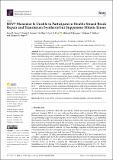| dc.contributor.author | Vassel, Faye M. | |
| dc.contributor.author | Laverty, Daniel J. | |
| dc.contributor.author | Bian, Ke | |
| dc.contributor.author | Piett, Cortt G. | |
| dc.contributor.author | Hemann, Michael T. | |
| dc.contributor.author | Walker, Graham C. | |
| dc.contributor.author | Nagel, Zachary D. | |
| dc.date.accessioned | 2023-11-13T18:13:52Z | |
| dc.date.available | 2023-11-13T18:13:52Z | |
| dc.date.issued | 2023-10-31 | |
| dc.identifier.uri | https://hdl.handle.net/1721.1/152941 | |
| dc.description.abstract | Rev7 is a regulatory protein with roles in translesion synthesis (TLS), double strand break (DSB) repair, replication fork protection, and cell cycle regulation. Rev7 forms a homodimer in vitro using its HORMA (Hop, Rev7, Mad2) domain; however, the functional importance of Rev7 dimerization has been incompletely understood. We analyzed the functional properties of cells expressing either wild-type mouse Rev7 or Rev7<sup>K44A/R124A/A135D</sup>, a mutant that cannot dimerize. The expression of wild-type Rev7, but not the mutant, rescued the sensitivity of Rev7<sup>−/−</sup> cells to X-rays and several alkylating agents and reversed the olaparib resistance phenotype of Rev7<sup>−/−</sup> cells. Using a novel fluorescent host-cell reactivation assay, we found that Rev7<sup>K44A/R124A/A135D</sup> is unable to promote gap-filling TLS opposite an abasic site analog. The Rev7 dimerization interface is also required for shieldin function, as both Rev7<sup>−/−</sup> cells and Rev7<sup>−/−</sup> cells expressing Rev7<sup>K44A/R124A/A135D</sup> exhibit decreased proficiency in rejoining some types of double strand breaks, as well as increased homologous recombination. Interestingly, Rev7<sup>K44A/R124A/A135D</sup> retains some function in cell cycle regulation, as it maintains an interaction with Ras-related nuclear protein (Ran) and partially rescues the formation of micronuclei. The mutant Rev7 also rescues the G2/M accumulation observed in Rev7<sup>−/−</sup> cells but does not affect progression through mitosis following nocodazole release. We conclude that while Rev7 dimerization is required for its roles in TLS, DSB repair, and regulation of the anaphase promoting complex, dimerization is at least partially dispensable for promoting mitotic spindle assembly through its interaction with Ran. | en_US |
| dc.publisher | Multidisciplinary Digital Publishing Institute | en_US |
| dc.relation.isversionof | http://dx.doi.org/10.3390/ijms242115799 | en_US |
| dc.rights | Creative Commons Attribution | en_US |
| dc.rights.uri | https://creativecommons.org/licenses/by/4.0/ | en_US |
| dc.source | Multidisciplinary Digital Publishing Institute | en_US |
| dc.title | REV7 Monomer Is Unable to Participate in Double Strand Break Repair and Translesion Synthesis but Suppresses Mitotic Errors | en_US |
| dc.type | Article | en_US |
| dc.identifier.citation | International Journal of Molecular Sciences 24 (21): 15799 (2023) | en_US |
| dc.contributor.department | Massachusetts Institute of Technology. Department of Biology | |
| dc.identifier.mitlicense | PUBLISHER_CC | |
| dc.eprint.version | Final published version | en_US |
| dc.type.uri | http://purl.org/eprint/type/JournalArticle | en_US |
| eprint.status | http://purl.org/eprint/status/PeerReviewed | en_US |
| dc.date.updated | 2023-11-10T14:58:01Z | |
| dspace.date.submission | 2023-11-10T14:58:01Z | |
| mit.license | PUBLISHER_CC | |
| mit.metadata.status | Authority Work and Publication Information Needed | en_US |
